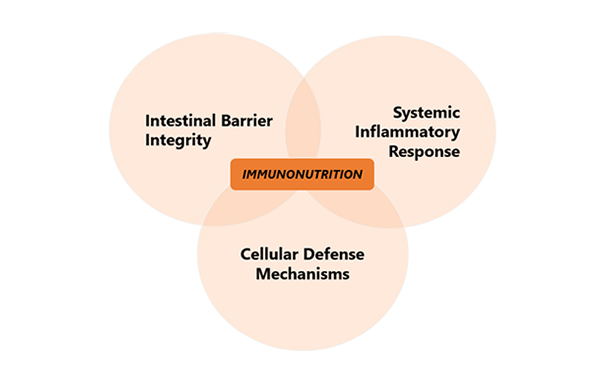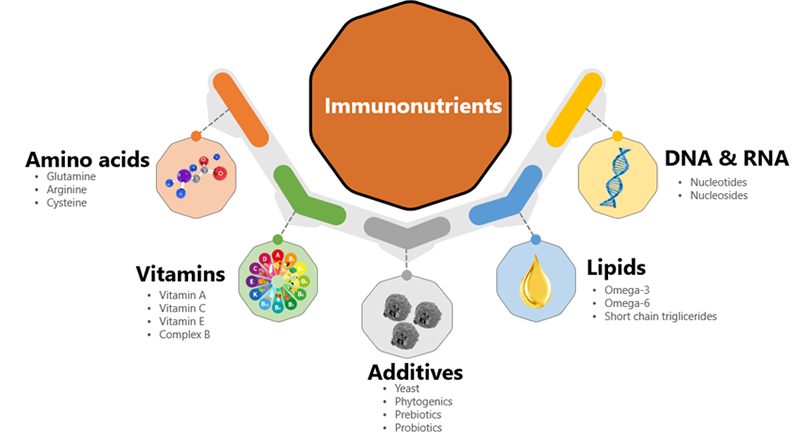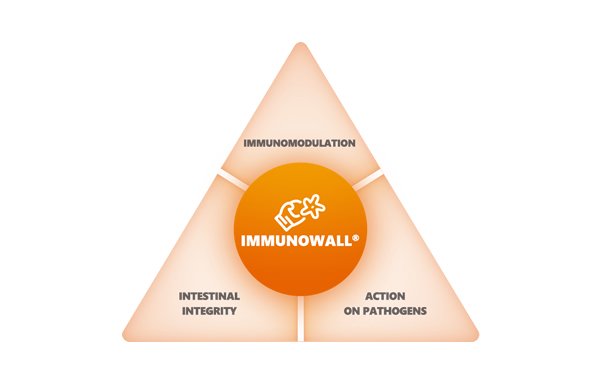Immunonutrition concepts applied to animal production
The term “immunonutrition” originated from studies carried out in the 1950s, with the suggestion that there is a relationship between malnutrition and infections (Shetty, 2010). Starting in the 1970s, this concept began to be broken down into 4 general lines of how nutrition can impact the immune response:
- Malnutrition (especially protein-energy related) and nutrient deficiencies;
- Nutrition as a determining factor on immune capacity in newborns and the elderly;
- The influence of obesity and excessive nutrients intake on an individual’s immunocompetence;
- And, how the interactions between nutrition and immunity impact clinical medicine and public health (Chandra, 1993).

This concept has been understood and applied to animal nutrition for a long time, since knowledge in the areas of nutrition, health, management and environment is quite advanced; however, only a few years ago, the term “immunonutrition” has been effectively applied. According to McCowen & Bistrian (2003) are classified as immunonutrients:

It is important to understand that the gastrointestinal tract, in addition to being responsible for digestion and absorption, is also an organ responsible for immune responses. Thus, the development and maturation of the immune system can be impacted by external factors (environment, management, sanitary conditions, diet, etc.) and animal-inherent factors (genetics, age). These factors also have an impact on gut microbiota and health. The gut microbiota performs several functions in the body and plays an important role in the bidirectional communication in the gut-brain axis (Cryan & Dinan, 2012). That is, the central nervous system (CNS), via the hypothalamic-pituitary axis, can be activated in response to stressors and, as a result, release cortisol. The cortisol will affect immune cells, which will initiate the release of pro-inflammatory cytokines, which in turn will affect intestinal permeability, which will allow a change in the microbiota (Landeiro, 2016).
The intestinal epithelium, in addition to having the function of absorbing nutrients, also acts as a physical barrier. If intestinal permeability is affected, intestinal microorganisms and lipopolysaccharides (LPS) may pass into the lamina propria, activating immune system cells and releasing pro-inflammatory cytokines that will impact the CNS and the enteric system (Gareau et al., 2008). Several metabolic changes can result from these responses, such as fever, metabolic inefficiencies, skeletal muscle catabolism and acute-phase protein synthesis (Korver, 2006). That is, they will impact the diversion of nutrients and energy that would be used for growth.
Thus, a prolonged pro-inflammatory response generated by any of these aforementioned factors can lead to an impairment of the animal’s immunocompetence. It is extremely important that the animal has its capacity of response and protection built throughout its life, i.e., modulated day by day; as the metabolic cost in this case versus an induced immune response is low and will directly impact the maintenance of metabolic homeostasis.
The intestinal epithelium, in addition to having the function of absorbing nutrients, also acts as a physical barrier. If intestinal permeability is affected, intestinal microorganisms and lipopolysaccharides (LPS) may pass into the lamina propria, activating immune system cells and releasing pro-inflammatory cytokines that will impact the CNS and the enteric system (Gareau et al., 2008). Several metabolic changes can result from these responses, such as fever, metabolic inefficiencies, skeletal muscle catabolism and acute-phase protein synthesis (Korver, 2006). That is, they will impact the diversion of nutrients and energy that would be used for growth.
Thus, a prolonged pro-inflammatory response generated by any of these aforementioned factors can lead to an impairment of the animal’s immunocompetence. It is extremely important that the animal has its capacity of response and protection built throughout its life, i.e., modulated day by day; as the metabolic cost in this case versus an induced immune response is low and will directly impact the maintenance of metabolic homeostasis.
In conclusion, substances that may have an influence on the microbiota, intestinal permeability and the immune system (immunonutrients) are interconnected with health, well-being and growth. There is still much to be studied on the microbiota-gut-brain axis, given the complexity of the related factors; however, the use of immunonutrients, either isolated or in combination, provides benefits already proven in different species. Therefore, knowing their mode of action is essential to carry out the correct monitoring, measure the expected benefits and quantify the returns on investment.

Bibliographic references
Chandra, R. Nutrition and the immune system. Proceedings of the Nutrition Society, 52(1): 77-84, 1993.
Cryan, J. F.; Dinan, T. G. Mind-altering microorganisms: the impact of the gut microbiota on brain and behaviour. Nature Reviews Neuroscience, 13(10): 701–712, 2012.
Gareau, M. G.; Silva, M. A.; Perdue, M. H. Pathophysiological mechanisms of stress-induced intestinal damage. Corrent Molecular Medicine, 8(4): 274–281, 2008.
Korver, D. R. Overview of the Immune Dynamics of the Digestive System. Journal of Applied Poultry Research, 15:123–135, 2006.
Landeiro, J. A. V. R. Impacto da microbiota intestinal na saúde mental. Tese (Doutorado em Ciências Farmacêuticas) – Instituto Superior de Ciências da Saúde Egas Moniz, Almada, Portugal, 81p, 2016.
McCowen K.C; Bistrian B.R. Immunonutrition: problematic or problem solving? The American Journal of Clinical Nutrition, 77(4):764–70, 2003. Shetty, P. Nutrition, immunity e infection. Paperback: 224 pages; Publisher: CABI Publishing; 1 edition 2010
Chandra, R. Nutrition and the immune system. Proceedings of the Nutrition Society, 52(1): 77-84, 1993.
Cryan, J. F.; Dinan, T. G. Mind-altering microorganisms: the impact of the gut microbiota on brain and behaviour. Nature Reviews Neuroscience, 13(10): 701–712, 2012.
Gareau, M. G.; Silva, M. A.; Perdue, M. H. Pathophysiological mechanisms of stress-induced intestinal damage. Corrent Molecular Medicine, 8(4): 274–281, 2008.
Korver, D. R. Overview of the Immune Dynamics of the Digestive System. Journal of Applied Poultry Research, 15:123–135, 2006.
Landeiro, J. A. V. R. Impacto da microbiota intestinal na saúde mental. Tese (Doutorado em Ciências Farmacêuticas) – Instituto Superior de Ciências da Saúde Egas Moniz, Almada, Portugal, 81p, 2016.
McCowen K.C; Bistrian B.R. Immunonutrition: problematic or problem solving? The American Journal of Clinical Nutrition, 77(4):764–70, 2003. Shetty, P. Nutrition, immunity e infection. Paperback: 224 pages; Publisher: CABI Publishing; 1 edition 2010
